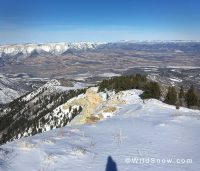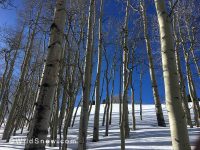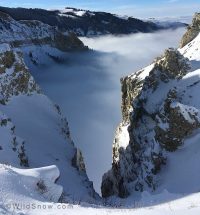
Looking south in to Porcupine Slide over a sea of clouds. Colorado Bookcliffs are visible to the far left.
I think of myself as a fairly sporting chap in regards to weather. But as bursts of sideways driving snow pelt the Gumption wagon’s thin metal shell, the feet I just stuffed into cold Dynafit boots are reluctant to move from the relative warmth and calm shelter of the cab.
I tell myself the storm is coming in bursts, and if I just get out and start moving there may be a clear, calm patch in the weather that lasts long enough for the descent. Even now it is becoming a little less grey, and the pelleting barrage has eased.
The relative calm holds, and I pull out my pack, clip into my skis, and begin skinning up the road. The grader has not been through for at least a day, there is a solid base of snow on the road; enough to feel like proper skinning, not a road climb.
Even so, I can’t resist the urge to explore. An open glade up the hill appears to line up with the drainage in front of me, so I leave the road and begin weaving through the trees. The challenge in this area is finding a route through the chokecherry and aspen saplings that grow in a dense, thicketed band across the slope.
A few hundred feet into my exploring, I come across a skin track. A few strides more, a man making elegant telemark turns through the closely spaced trees appears. His name is Gary, and we both conclude it is possible we have met up here before. He has been skiing it for 15 years, me for three.
We exchange route beta, acknowledging the difficulties in navigating certain sections, the joys of others. We discuss the plans for a new road, the local multi user group, wish each other rewarding journeys, and go our separate ways. This is why we are in the woods.
I follow Gary’s skin track for a good bit, enjoying the low-angle climbing. But one switchback heads away from my objective, so I turn around to backtrack a more direct approach.
It’s a good sign when in the most uncontrolled skiing stances, heel flailing freely, and climbing skins on your bases, that the powder already makes you feel like a hero.
By the time I reach the meadow below Shark Park, whirlwinds of snow are racing across the open space, vortices of disruption. I tuck my head down and shuffle my fastest towards the trees.
The snow that feels so light blowing through the air, and stinging on my face, piles up on my broad powder skis, and drags my feet slow as I try to reach the shelter of the aspen grove. I stop several times to breathe, look across the valley, and ponder routes off the ridge to the east.
It is calm in the aspen grove, with the mysterious depth of space that draws one ever deeper into the maze of white trunks. Gusts sway the upper branches and lift attention to the towering height of the forked columns.
More low-angle skinning seems to drag on longer than the steeper pitches. I recognize several routes I have skied in the past; there is more to this approach through the aspen grove than I estimated, more memories than I had counted on. In my earliest attempts, this was the part that was just steep enough. Now I worry it is too flat.
I am looking for a particular curved spruce tree that I have dreams of making a hut out of. It was obvious on the first routes I used, but I do not come across it today. Ahead is another promising grove of spruce. Nearby, a collection of deadfall aspen looks inviting at first, but more deadly the closer I get.
So I arc back to the biggest tree that first caught my eye. The deadfall hanging above this one looks stable. I spend several minutes examining it, fantasizing various ways the timber might be pulled down into a cozier shelter. Maybe someday the wind will blow it down for me.
After breaking off a few dead branches, the drooping boughs make for a welcome shelter to peel off climbing skins and switch to descent mode. I put the left tongue support in my right boot, which necessitates another process of unbuckling and rebuckling. It’s frustrating, but at least my fingers aren’t as frozen as my last time up here, when they took on the fumbling dexterity of ice cubes.
Under the towering spruce it is calm. I reflect on how well my clothing choice has worked out today: the layers of wool long sleeves, which are my favorites for warmth, wicking, and stink resistance. The Kinco gloves with hand warmer packets stuffed inside, clipped together, and hanging in the crotch of my bibs are doing more to keep me warm than they ever have on my hands. A cheap pair of insulated welding gloves have become new favorites for keeping my hands toasty.
Layered over the wool is a western style vest I picked up at a Carbondale yard sale. A family was selling off the last possessions of their father, who was apparently deceased, or worse, moved into a retirement home. Judging by the possessions for sale, he had been a cowboy. Before Carbondale became a locus of hippies, art freaks, and yoga pants, the wide open spaces below Mt. Sopris were prime ranching land.
That was before my time. Now it is ranchettes, McMansions, HOAs, prayer flags, and people complaining that the lights are too bright. I find that all entertaining, but feel a stronger sense of empathy with this displaced old cowboy.
In addition to his vest, I purchased his set of Time-Life The Old West books. It is a 20-something volume collection of classic western paintings, narratives, and history of the settling of the American West. These books placed The West on an equal level of mythological footing with King Arthur and the Knights of the Roundtable.
When I moved to western Colorado and saw the very landscapes that had only been fantastical paintings, I could have not been more stunned had I seen dragons flying out of the sky. Not just the landscapes, but some of the very same buildings, and descendants of some of the storied characters were here: real live crotchety cowboys who distrusted electrical appliances, drank whiskey sooner than water, and ate venison rather than beef, as beef was too valuable; miners as sure with a sledge as John Henry with his hammer; and those who wandered just for the wonder of it all.
I could not be a cowboy or a miner for I did not start early enough in life to be cast in the necessary resilience for such molds, but I have been a wandering wonderer from the time that my feet could carry my restless mind far enough to seek peace on my own.
This land I never knew existed, with its vast views, and untrammeled access, is perfect for drifting souls such as myself. The Beaver Creek drainage (every locale in the West has a Beaver Creek; usually next to Cottonwood Creek) is an excellent venue for ambling minds and feet. High above the pinyon-juniper and adobe desert that surrounds my Colorado home is another world of massive spruce and towering aspen. Looking down on the desert from a field of snow fringed by sub-alpine forest is a deliciously surreal treat, and prompts me wonder if the cowboy whose vest I’m wearing has any memories of views like this. If his spirit is still tagging along in the fibers of this vest, I hope he can see, and enjoy the magic of the wide-open West one more time.
Under the sheltering spruce tree nearly 3 feet in diameter, I click into my skis, grasp my poles, and look down through the aspens for my route.
The snow is thick and heavy, forcing me to lean back to keep my tips above the surface on these flatter sections.
Once I make it to where the terrain rolls over into a steeper pitch, the skiing transforms from back seat driving to carving arcing turns through the open spaces between the aspens; a hybrid dance of floating and falling, surfing and carving across the dense, supportive snow. My big ol’ powder sticks lay out trenches that would make snowboards proud, and I head for every huck I see with a heroism fueled by deep powder.
Normally, the run is broken up with several route-finding stops, trying to find a line through the thicker stands of brush and the saplings. But today the turns keep linking themselves together, dancing down the slope through aspen pillars, a temple of flow in my own private Parthenon.
The paradox is that the more seamlessly the turns link themselves together, the longer the uninterrupted flow of open spaces between the trees, the more surely my skis lead me from one whoop of joy to the next, the quicker it is all over.
By the time I have to slow down for some crux choices between spruce trees and chokecherry thicket, the road is only a few hundred feet below.
I point my skis into a narrow slot between the branches, shoot for the open plunge of the gully, remember to duck way down to my knees to clear the overhanging limb, fumble blindly in the backseat for a few moments, carve a few more turns around the boulder pillows in the drainage before coming to the last spruce/thicket barrier.
Parked on top of a small pillow, I survey the weave of branches below the spruce boughs. A small corridor is made even more narrow by a dead sapling that chokes the path into a V just wide enough for my skis to fit through.
I slide through like a cat squeezing through a not-quite-closed-door, and rush towards the last field of powder. A boulder drop is the quickest way down, and I choose to press “send” instead of the long way around.
A small victory pump of my skis mid-air, and I extend my legs for landing, touchdown in the soft powder, and come back to earth with the realization it is over.
My last turn arcs, and stalls at the edge of the snowbank above the road. I stand there for a long time in my ski boots and vest, clipped into my skis, reluctant to leave such a transcendent experience behind to return back down the road to reality. I think of the old cowboy, and wonder what he would do; sensibility, or heroism?
I weigh the amount of daylight remaining against my cold fingers, the fumbling changeover of stepping out of skis, trying not to sink in the snow while stretching out skins, unbuckling boots to remove the stiff tongues, buckling and strapping the pack back together to race uphill against the dying sun.
Instead, I point my skis to the road, drop down the snowbank, and praise Ullr for the fresh carpet of snow not yet swept away by the road grader’s blade. With this magic cushion of water and air, the low-angle cruise is more pleasant than many resort laps I’ve experienced. It’s a hoverboard sensation of just skimming along the surface of the earth, the laws of friction suspended. I slither a few hundred meters down the road to the top of the switchback, then side-step my way to the top of the roadbank for one last powder hit. It gets me a small air, and few last weaves through the trees before reconnecting to the road. The square cut of the snowbank has softened into an inviting radius, and I do my best park rat impersonation of leaning back into tail presses to surf up on the bank, slash down to the road, and aim for the other side, compacted crunchy boulders of snow swept to the side by the grader’s blade.
Near the gate, the road steepens, and the speed picks up closer to actual skiing speed, not just noodling along. The bank surfing sensation becomes more satisfying. I remember to straight line it for the step up across the skin track — I came up short here the other day. Racer tuck for a few moments, then a pump, a jump, and I clear the skin track to land on the uphill side, then surf back down to the road and my vehicle.
The Gumption wagon is cold and metallic, and does not carry the warm, earthy, hobbit-hole smell that comes once the heater has warmed up the accumulated dust and dirt that wafts in through the porous shell. I am warm, the blood still coursing hot and fast next to my skin as I swing my pack in like an awkward fabric kettle bell, remembering not to leave my poles stashed in the snowbank like I did last time. My feet slide out of toasty ski boots into cold hiking boots.
I pull the choke, crank the 22r over until it coughs, sputters, and fires, then hold the gas pedal to keep the revs up until the next round of hacking signals the first stage of warm-up, then push the choke in, and hold the rpms for the second stage of warming till the engine will idle on its own.
As the truck warms up and my body cools down, I think of the cowboy who inhabited this vest before me. We never met, but I feel a kindred connection in our wonder of the West. I doubt if he ever went skiing, but I am certain he loved the outdoors. He would be proud of me for venturing out. I’m not sure where he is these days, but am glad to carry his spirit with me in the blue and cream vest, as I explore the West that was once the land of fables to me, and is now my adopted home.
(Guest blogger Aaron Mattix grew up in Kansas and wrote a report on snowboarding in seventh grade. His first time to attempt snowboarding was in 2012, and soon switched over to skis for backcountry exploration near his home in Rifle, CO. His skill level is “occasionally makes complete runs without falling.” In the summer, he owns and operates Gumption Trail Works, building mountain bike singletrack and the occasional sweet jump.)
Aaron Mattix grew up in Kansas and wrote a report on snowboarding in seventh grade. His first time to attempt snowboarding was in 2012, and soon switched over to skis for backcountry exploration near his home in Rifle, CO. From snow covered alleys to steeps and low angle meadows, he loves it all. In the summer, he owns and operates Gumption Trail Works, building mountain bike singletrack and the occasional sweet jump.



